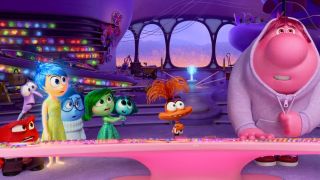Adolescence
Inside Out 2 Takes on the Complexity of Adolescence
For teens, emotions are the start, but a secure identity is the goal.
Posted July 7, 2024 Reviewed by Kaja Perina
Key points
- Adolescence is difficult to go through and equally hard to capture on the big screen.
- Pixar's Inside Out 2 moves beyond emotions toward the task of identity formation.
- Psychologists, including Erik Erikson, have explored the complexity of adolescence.
- Although the adolescent is required to "do the work" of identity formation, peers and adults help or hinder.

As a psychologist with a specialization in adolescence, I appreciated the psychological maturity of Pixar’s Inside Out 2. Although exaggerated at times (after all, they only had an hour and a half to summarize adolescence), the film did a commendable job of illustrating the challenges facing our children today.
The Storm and Stress of Adolescence
Way back in 1904, American psychologist G. Stanley Hall wrote of the “storm and stress” of adolescence including mood disruption, risky behavior, and conflict with parents. He also highlighted the sensitivity of feelings in adolescence. All of this is on display in the film as thirteen-year-old Riley reacts wildly to emotional input at “headquarters,” and she allows anxiety to over-ride her better judgment by sneaking into the coach’s office to read her scouting report.
If G. Stanley thought adolescence was complicated at the turn of the last century, I can only imagine his view of the additional, new challenges that today’s teenagers face, from social media to bullying to the highest of societal expectations. Fittingly, psychology’s view of adolescence has become more nuanced and more biologically based.
The film does itself, and adolescence credit, by highlighting the emotional complexity of this stage of life (Joy, Sadness, Disgust, and Fear are joined by Anxiety, Ennui, Envy, and Embarrassment). Better yet, the movie transcends these more transient emotional states by introducing the more enduring Sense of Self. This is the true task and challenge of adolescence.
Identity versus Role Confusion
The child psychoanalyst Erik Erikson is often known for his psychosocial stages of development. The movie’s main character, Riley is struggling with the virtue of Fidelity.
According to Erikson, she is attempting to successfully navigate the stage of Identity versus Role Confusion. Success means the formation of an identity that is in alignment with society’s standards and expectations. Role confusion is the alternative, with the child not reaching an acceptable identity but rather continually searching in vain for a suitable one.
Parents and Peers
As parents, we are faced with the daunting task of allowing children to explore their own identities while providing necessary boundaries and feedback. Telling adolescents what to believe and how to act usually backfires because they must come to these conclusions on their own. We also know now that the brain is not yet fully formed until the mid or even late twenties, which is a seriously limiting factor.
Still, identity is not formed in a vacuum. If adolescents act in a harmful or destructive way, it is the job of parents, educators, and other important adults to maintain the guardrails and bump them back into an acceptable societal lane. Of course, our view and their view of what is acceptable is not identical. There’s the rub.
Equally challenging, the adolescent must also navigate peer expectations, as illustrated in the film with Riley struggling to please the older, “cooler” hockey players at the expense of her current friends. I know of at least one child that was bullied at summer camp for not liking Taylor Swift. Society can be cruel to the individualistic.
A Good Resolution
There is no way to skip the stage of Identity versus Role Confusion, just as there is no shortcut through adolescence. While it can be a time of embarrassment and blunders, successfully navigating this stage leads to a lifelong gift for our children: a stable identity that serve as a reliable lighthouse in any storm that life sends their way.
References
Hall, G. S. (1904). Adolescence: Its psychology and its relations to physiology, anthropology, sociology, sex, crime, religion, and education (Vols. I & II). New York: D. Appleton & Co.
Erikson, E. H. (1994). Identity and the life cycle. WW Norton.


